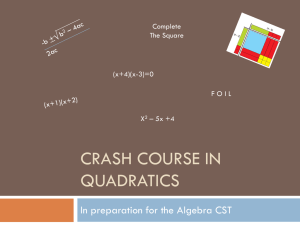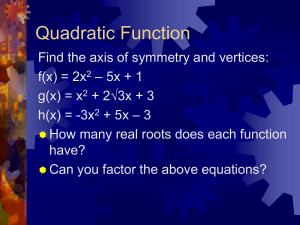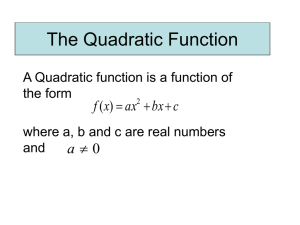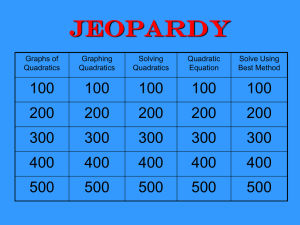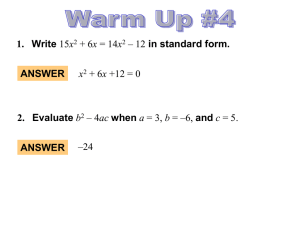Class 2: Objectives
advertisement
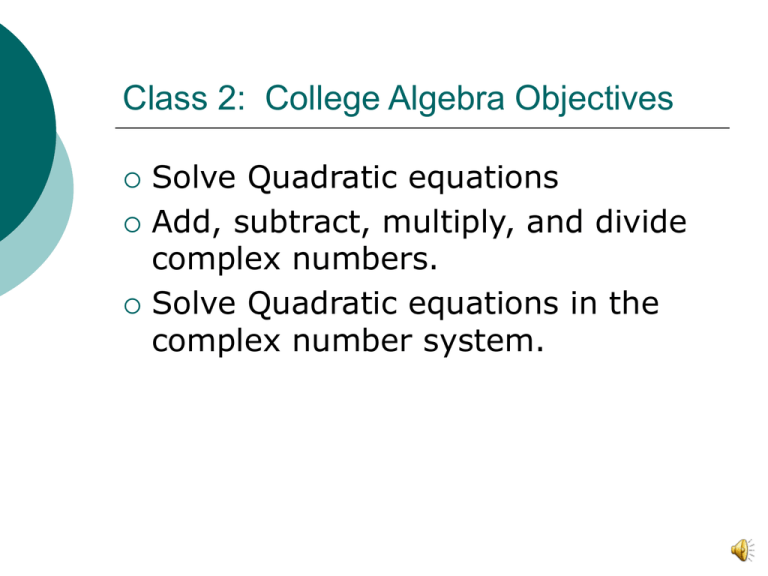
Class 2: College Algebra Objectives Solve Quadratic equations Add, subtract, multiply, and divide complex numbers. Solve Quadratic equations in the complex number system. Quadratic Equations Quadratic Equations can be identified by having a degree of 2 (squared variable). Several methods to solve Factoring Square Root Method Quadratic Formula POLY Multiply the following: (2x + 3)(3x – 7) Distribute the first quantity through the second quantity 2x(3x – 7) + 3(3x – 7) 6x2 – 14x + 9x – 21 6x2 – 5x – 21 Notice the first term comes from the factors at the front of the parenthesis. Notice the last term comes from the factors at the back of the parenthesis Notice the middle term comes from adding the products of the inside terms and the outside terms Process Regardless of what method of solving the quadratic equation must first be put into standard form. ax2 + bx + c = 0 Factoring Check for like terms Factors of first term go at front of parenthesis Factors of last term go at back of parenthesis Check for Middle Term Set each factor equal to zero and solve Check answer/s Examples: Solve x2 + 6 = 5x Standard Form: x2 – 5x + 6 = 0 Check for like terms None Factors of first term go at front of parenthesis: (x )(x )=0 Factors of last term go at back of parenthesis: (x – 2)(x – 3) = 0 Check for Middle Term: -2x + -3x = -5x Set each factor equal to zero and solve x – 2 = 0 x – 3 = 0 -> x=2 or x=3 Check answer/s 22 + 6 = 5(2) 10 = 10 32 + 6 = 5(3) 15 = 15 Example: Solve 2x2 = x + 3 Standard Form: 2x2 – x – 3 = 0 Check for like terms Factors of first term go at front of parenthesis: (2x )(x )=0 Factors of last term go at back of parenthesis: (2x – 3)(x + 1) = 0 Check for Middle Term: -3x + 2x = -1x Set each factor equal to zero and solve 2x – 3 = 0 x+1=0 2x = 3 x = -1 Check answer/s Example: Solve 9x2 – 6x + 1 = 0 Standard Form: Check for like terms Factors of first term go at front of parenthesis: (3x )(3x )=0 Factors of last term go at back of parenthesis (3x – 1)(3x – 1) = 0 Check for Middle Term: -3x + -3x = -6x Set each factor equal to zero and solve: 3x – 1 = 0 3x – 1 = 0 3x = 1 3x = 1 x = 1/3 x = 1/3 Check answer/s Double Root: have two of the same answer Square Root Method Can only be used when one variable exists and that variable is squared. Move numbers away from squared term. Take the square root of each side (remember the +- sign) Solve the remaining equation Check answer/s Example: Solve x2 = 49 X2 = 49 Only one variable that is squared. Can take a square root to cancel square with variable. Remember that a variable could be a positive or negative value whose square is positive. Sqrt (x2) = + Sqrt 49 Square and square root cancel with variable leaving: X=+7 Check Answers 72 = 49 (-7)2 = 49 Example: Solve (x – 2)2 = 25 Only one variable so can solve by “doing opposite”. Take square root of both sides (remember + ) Sqrt(x-2)2 = + sqrt (25) Solve for x by moving numbers away from variable. X–2=5 x – 2 = -5 X=7 x = -3 Check (7 – 2)2 = 25 (-3 – 2)2 = 25 Example: Solve (x + 1)2 - 3 = 1 Isolate squared term (x + 1)2 = 4 Take square root of both sides Sqrt (x + 1)2 = + sqrt 4 Solve for x X+1=2 x + 1 = -2 X=1 x = -3 Check (1 + 1)2 – 3 = 1 (-3 + 1)2 – 3 = 1 Quadratic Formula Quadratic Formula was developed from a process called “completing the square”. Quadratic Formula: X = (-b + sqrt(b2 – 4ac)) / 2a Discriminant: portion under the square root b2 – 4ac Discriminant Rules: We will use these rules when solving quadratic equations in the complex number system (next class). b2 – 4ac > 0 : two unequal real solutions b2 – 4ac < 0: two complex conjugate solutions (no real solutions) b2 – 4ac = 0 : one root which occurs twice - a root of multiplicity 2 (double root) Examples: Solve 3x2 – 5x = -1 1. Standard Form 3x2 – 5x + 1 = 0 2. Identify a, b, and c a=3 b = -5 c=1 3. Plug values into the quadratic formula and simplify (5 + sqrt(25 – 4(3)(1)))/ 2(3) (5 + sqrt 13) / 6 4. Check solutions: use calculator and decimal approximations to check solutions. 3 ((5 + sqrt 13) / 6)2 – 5((5 + sqrt 13) / 6) = -1 3 ((5 - sqrt 13) / 6)2 – 5((5 - sqrt 13) / 6) = -1 Example: Solve (25/2) x2 – 30x + 18 = 0 Multiply both sides by common denominator to eliminate denominator 2(25/2)x2 – 2(30)x + 2(18) = 0 25x2 – 60x + 36 = 0 Standard Form: 25x2 – 60x + 36 = 0 Identify a, b, and c: a = 25, b = - 60, c = 36 Solve with quadratic formula – once you have a solution click enter to check your answer. X = 6/5 Check answer 12.5(6/5)2 – 30(6/5) + 18 = 0 Solve: 9 + 3/x – 2/x2 = 0 Multiply by common denominator to eliminate fractions x2( 9 + 3/x – 2/x2) = x2(0) 9x2 + 3x - 2 = 0 Put in standard form: 9x2 + 3x - 2 = 0 Identify a, b, c Use quadratic formula to solve x = -2/3 x = 1/3 Check answer Solve: 2x2 – 5x + 3 = 0 Solve this problem on your own. Once you have an answer click “enter” to check your answer. If you do not have the correct answer, please see Mrs. Dorshorst for help. x = 3/2 x=1 Application From each corner of a square piece of sheet metal, remove a square of side 9 centimeters. Turn up the edges to form an open box. If the box is to hold 144 cubic centimeters, what should be the dimensions of the piece of sheet metal? From each corner of a square piece of sheet metal, remove a square of side 9 centimeters. Turn up the edges to form an open box. If the box is to hold 144 cubic centimeters, what should be the dimensions of the piece of sheet metal? Volume: Amount that container holds. Volume = length x width x height x – 18 X - 18 From each corner of a square piece of sheet metal, remove a square of side 9 centimeters. Turn up the edges to form an open box. If the box is to hold 144 cubic centimeters, what should be the dimensions of the piece of sheet metal? Volume: Length: x – 18 Width: x – 18 Height: 9 V = 9 (x – 18)(x – 18) 144 = 9(x - 18)2 144/9 = (x – 18)2 + 12/3 = x - 18 + 4 + 18 = x -> 22 = x - 4 + 18 = x -> 14 = x Discard the 14 as the dimension of the side. Why? Sides would be 22 cm by 22 cm. Example: A ball is thrown vertically upward from the top of a building 96 feet tall with an initial velocity of 80 ft/sec. The distance s (in feet) of the ball from the ground after t seconds is s = 96 + 80t – 16t2 After how many seconds does the ball strike the ground? After how many seconds will the ball pass the top of the building on its way down? A ball is thrown vertically upward from the top of a building 96 feet tall with an initial velocity of 80 ft/sec. The distance s (in feet) of the ball from the ground after t seconds is s = 96 + 80t – 16t2 How long before ball is on the ground? When the ball is on the ground the distance is 0. 0 = 96 + 80t – 16t2 Put in standard form then solve by quadratic formula a = -16, b = 80, c = 96 t = 6 sec A ball is thrown vertically upward from the top of a building 96 feet tall with an initial velocity of 80 ft/sec. The distance s (in feet) of the ball from the ground after t seconds is s = 96 + 80t – 16t2 How long before ball reaches top of building? Reaches top of building when s=96 96 = 96 + 80t – 16t2 Can solve by factoring or by using quadratic formula. Get in standard form first then solve. t = 5 sec Assn: Page 106 #9, 11, 15, 21, 39, 49, 61, 65, 79, 85, 95, 99, 105




